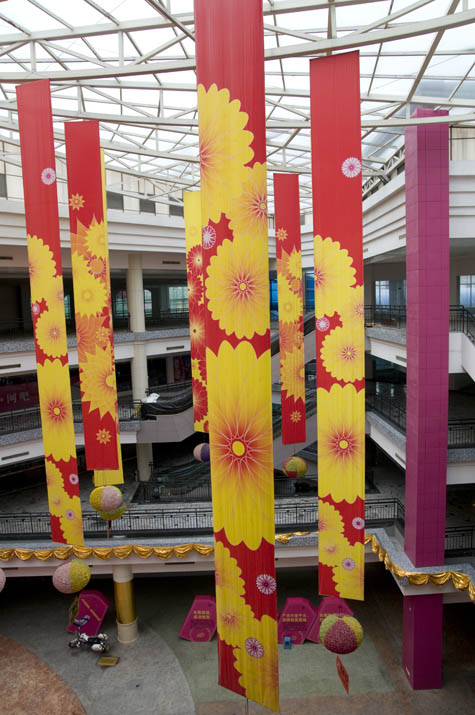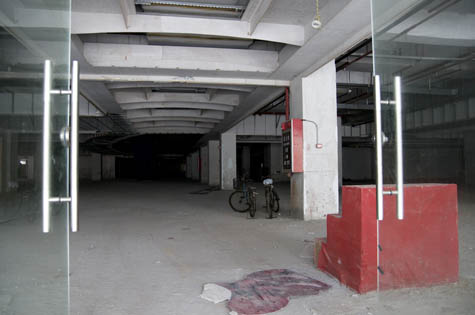 [Image: South China Mall, photographed by Philip Gostelow for The National].
[Image: South China Mall, photographed by Philip Gostelow for The National].Last week, Jonathan Shainan of Abu Dhabi's The National newspaper sent in a link to their recent article about a rather interesting mall over in China.
That mall, we read, is "not just the world’s largest. With fewer than a dozen stores scattered through a space designed to house 1,500, it is also the world’s emptiest – a dusty, decrepit complex of buildings marked by peeling paint, dead light bulbs, and dismembered mannequins."
- What sets the South China Mall apart from [other dead malls], besides its mind-numbing size, is that it never went into decline. The tenants didn’t jump ship; they never even came on board. The mall entered the world pre-ruined, as if its developers had deliberately created an attraction for people with a taste for abandonment and decay. It is a spectacular real-estate failure – but it is also, as I saw when I spent two days exploring the site in May, a strangely beautiful monument to the big dreams that China inspires.
Like the South China Mall, these are spaces that don't simply go into decline: their expected populations just never show up.
 [Image: South China Mall, photographed by Philip Gostelow for The National].
[Image: South China Mall, photographed by Philip Gostelow for The National].In any case, the architecture of the South China Mall is itself meant to inspire:
- The big attraction of the South China Mall was supposed to be its “foreign” design. Learning from Las Vegas, where replicas of European monuments and New York landmarks draw throngs of tourists, the Dongguan mall modeled seven zones after various exotic world locations. Its rooftops reflect at least twenty different influences, from Czech town halls to Turkish mosques.
 [Image: South China Mall, photographed by Philip Gostelow for The National].
[Image: South China Mall, photographed by Philip Gostelow for The National].The article's author, Michael Donohue, soon finds himself walking past drained indoor water park rides, bored security guards, and "escalators sheathed in dust-covered plastic."
"It's not very exciting," a 23 year-old shopper comments to Donohue. She is sitting on the edge of a decorative pond somewhere deep in the emptiness.
The rest of the article is worth reading. It explores how leasing difficulties led to this situation in the first place, and how China's burgeoning "mega-middle class" has simply not arrived on time to coincide with the opening of the mall.
But what kind of future might such a giant space hold? I'd suggest that it'd make an ideal setting for an architectural studio, if such a thing hadn't been done before. Boing Boing readers suggest turning it into a venue for paint ball, or even a set for future zombie films.
 [Image: South China Mall, photographed by Philip Gostelow for The National].
[Image: South China Mall, photographed by Philip Gostelow for The National].Less tangentially, Jonathan Shainin also sent me this link to an earlier article in The National about globe-trotting mega-mall designer – turned architect of whole Middle Eastern cities – Eric Kuhne. Kuhne – who is not responsible for the South China Mall, and I don't mean to imply that he is – has become somewhat notorious for his work designing Bluewater, the giant retail "city" outside London in northern Kent. Interestingly, that mall stands in the footprint of an old quarry.
My own first sense of the cultural hostility directed at Bluewater came while reading the 2002 novel Flood by Richard Doyle, wherein the whole complex is obliterated by the rising waters of an insurgent Thames. If I remember correctly, one of the characters is trying on clothes in a changing room when water begins to seep upward through the carpeted floor.
The National article suggests that, because "Kuhne himself described Bluewater as 'a city rather than a retail destination,' it is safe to assume that his cities may resemble his malls."
- This possibility excites Kuhne; he has faith in retail. “Retail,” he tells [an] audience in Dubai, “is the only industry that can manage our city centres… We are the only ones who deal with experience. We are the only ones that understand how to customise and modify and release and replan and reorganise and administer a luscious experience for a group.”
"He views himself," the article suggests, "not as a megamall designer turning cities into supermegamalls, but as a humanistic master planner creating 'mixed use' spaces that help people live and thrive together gracefully."
In any case, what imaginative role will the South China Mall, like some massive architectural folly, play in the region? Will it take up a place in urban legends, or in video games, or in films?
Or perhaps the South China Mall will be flooded in a new, bestselling novel by a young writer from Shanghai...
Perhaps, on the other hand, China's fabled mega-middle class will arrive just in time to make it thrive. This strange ruin will then see its walls replastered and its escalators fixed, and crowds of children will walk through its cavernous toy stores unaware that the space all around them had once been an uninhabited shell.
(Thanks to Jonathan Shainin for sending both article links and the photographs by Philip Gostelow!)
No comments:
Post a Comment